3D Skeletal System: Compact Bone, Spongy Bone, and Osteons—Oh My!
Posted on 1/31/13 by Courtney Smith
I couldn't resist.
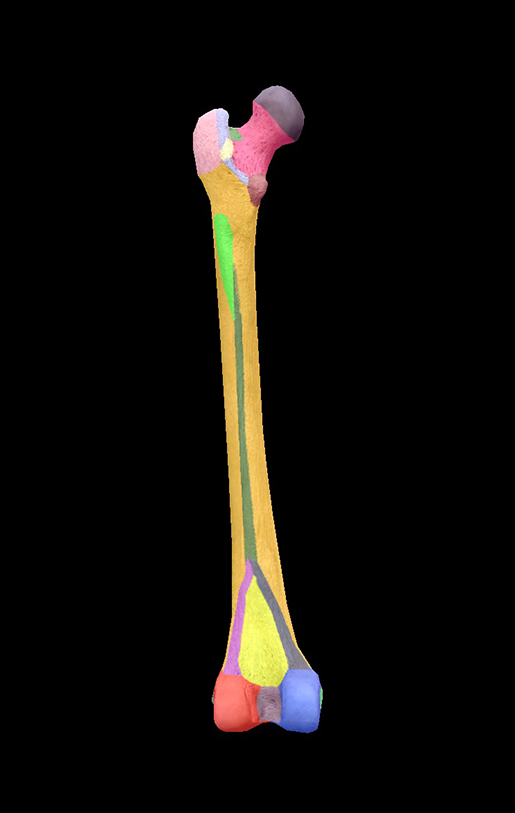 Femur landmarks. Image from Human Anatomy Atlas.
Femur landmarks. Image from Human Anatomy Atlas.
The point still stands! Your skeleton is an incredible structure. It gives your body shape, it protects vital organs, and it's alive. That's right! When you think of the skeleton, what comes to mind? Hard, dry bones, right? You can thank artistic conditioning in kindergarten for that one. The thing is, bones may be hard on the outside, but on the inside they're a smorgasbord of vessels, nerves, and other things. I may just blow your mind with this post.
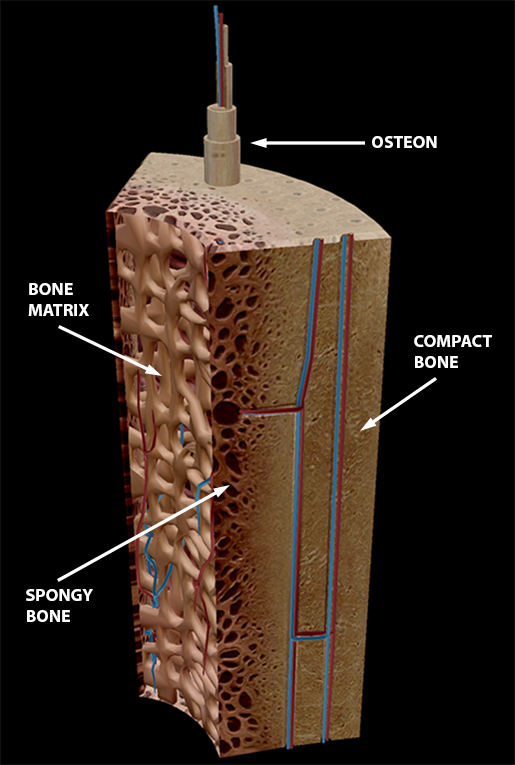 Image from Human Anatomy Atlas.
Image from Human Anatomy Atlas.
Compact Bone (Cortical Bone)
Compact bone is dense bone tissue found on the outside of a bone. Basically, in kindergarten when you drew skeletons, you were drawing compact bone. Compact bone is enclosed, except where it's covered by articular cartilage, and is covered by the periosteum. The periosteum is a thick fibrous membrane covering the entire surface of a bone and serving as an attachment for muscles and tendons. Vessels pass from the periosteum through pores into the compact bone and run through canals found throughout the tissue.
Spongy Bone (Cancellous Bone)
"Cancellous" makes it sound so negative, doesn't it? Spongy bone is on the interior of a bone and consists of slender fibers and lamellae—layers of bony tissue—that join to form a reticular structure. Spongy bone is supplied by fewer and larger vessels than compact bone. These vessels perforate the outer compact layer and are distributed into the spongy portion of bone, which is filled with marrow. Bone marrow is tissue found in long bones, like the femur, that contains stem cells.
Osteons (Haversian System)
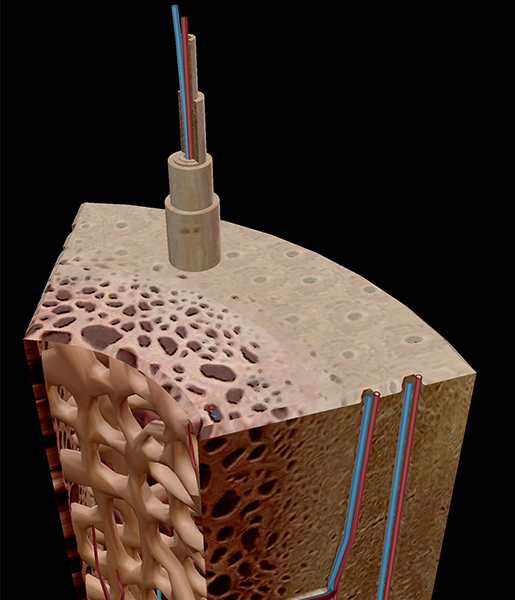 Image from Human Anatomy Atlas.
Image from Human Anatomy Atlas.
Osteons are interesting little things. Osteons are structural units of compact bone. Each osteon consists of a central canal, which contains nerve filaments and one or two blood vessels, surrounded by lamellae. Lacunae, small chambers containing osteocytes, are arranged concentrically around the central canal.
Femur Bone
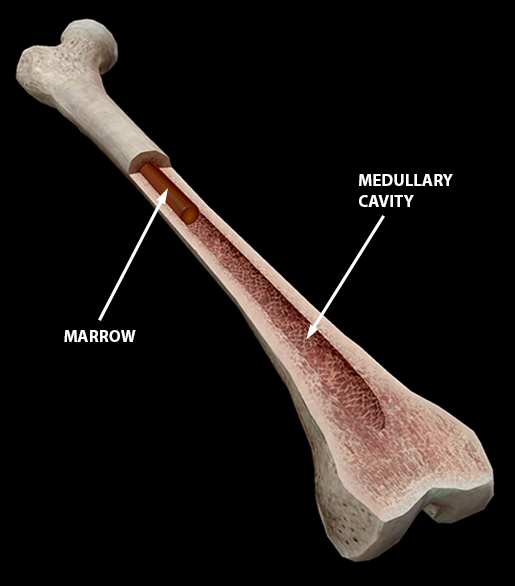 Image from Human Anatomy Atlas.
Image from Human Anatomy Atlas.
Bone marrow fills the cavities of long bones and occupies the spaces of spongy bone. Yellow marrow, consisting mostly of fat, is found in the central cavities of long bones. Red marrow is found in the medullary cavities of flat and short bones, articular ends of long bones, vertebral bodies, spongy bone of the cranium, sternum, ribs, and scapulae.
The femur is famous for being the longest bone in the body, as well as one of the strongest. Your femurs support a great deal of weight—your entire upper body, in fact! The femur is also known for its marrow-filled medullary cavity, which is present in all of the long bones of the limbs. The sternum and hip bone are the sites from which marrow is usually extracted, however the femur is also used.
Bone marrow biopsies are done usually to determine or diagnose certain conditions, such as leukemia, anemia, abnormal number of white blood cells, and whether cancer has spread to the bones.
Bone Marrow and Stem Cells
You've been bombarded by headlines about stem cells over the past decade, but what do they actually do? Well, stem cells can become red blood cells (which provide oxygen to tissue), white blood cells (which fight infections), or platelets (which help in blood clotting). They have the potential to become specialized cells, which can help in treating certain diseases.
Osteoporosis
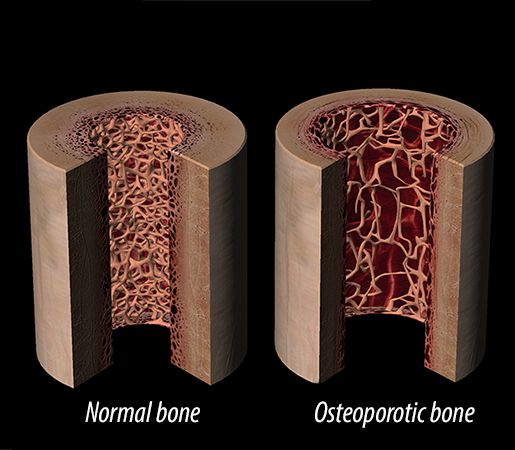
I drink seven or eight thousand glasses of milk a day. I love it, and my love for it helps protect me against osteoporosis. I'm sure you've seen dozens of ads telling you to drink milk or take vitamins to supplement bone health (Sally Field does one), but they never quite explain what osteoporosis is.
Osteoporosis is a disorder, more common with increased age, in which bone tissue becomes thinner, resulting in brittle bones that are more susceptible to breaking. Sex hormones are particularly important in stimulating bone cell growth; after middle age, these hormones decrease in production, which means bone cell growth decreases. Bones become noticeably thinner, especially for women after menopause when estrogen levels are very low.
Compact bone becomes more brittle, particularly in the long bones, which is why breaks and fractures in the tibia and femur are things to keep note of when diagnosed with osteoporosis. The femur and tibia already bear the weight of most of the body; small accidents, like simple falls, can result in injury. In spongy bone, trabeculae—small struts that are separated by cavities filled with marrow—become thinner and the spaces between them become wider, causing an overall weakening of bone structure.
While you know that milk is rich in calcium and vitamin D, the two most important nutrients for bone health, it's not the only one! Leafy greens like spinach, kale, and okra are high in calcium. Fatty fish like tuna and salmon, as well as cheese and egg yolks, are vitamin D-rich foods. About 99% of the calcium in our bodies is in our bones and teeth, and our bodies require vitamin D to absorb calcium. So the next time you're watching TV and Sally Field tells you that you need to eat things rich in calcium and vitamin D, you should listen. You should listen to her anyway, because she's awesome.
Be sure to subscribe to the Visible Body Blog for more anatomy awesomeness!
Are you a professor (or know someone who is)? We have awesome visuals and resources for your anatomy and physiology course! Learn more here.
Related Posts:
- 3D Skeletal System: Five Cool Facts about the Femur
- 3D Skeletal System: Function of the Sphenoid
- 3D Skeletal System: The Atlas, Axis, and Atlanto-Axial Relationship
Additional Sources:







